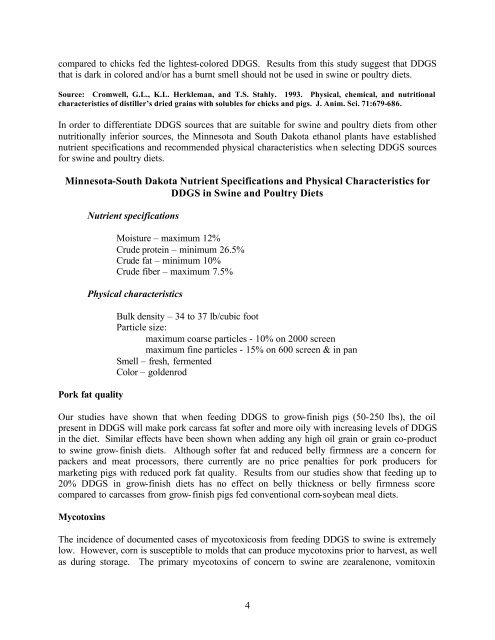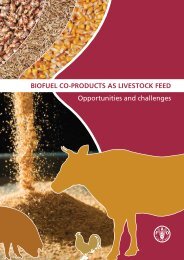Distillers Grains Feeding Recommendations. - Distillers Grains By ...
Distillers Grains Feeding Recommendations. - Distillers Grains By ...
Distillers Grains Feeding Recommendations. - Distillers Grains By ...
Create successful ePaper yourself
Turn your PDF publications into a flip-book with our unique Google optimized e-Paper software.
compared to chicks fed the lightest-colored DDGS. Results from this study suggest that DDGSthat is dark in colored and/or has a burnt smell should not be used in swine or poultry diets.Source: Cromwell, G.L., K.L. Herkleman, and T.S. Stahly. 1993. Physical, chemical, and nutritionalcharacteristics of distiller’s dried grains with solubles for chicks and pigs. J. Anim. Sci. 71:679-686.In order to differentiate DDGS sources that are suitable for swine and poultry diets from othernutritionally inferior sources, the Minnesota and South Dakota ethanol plants have establishednutrient specifications and recommended physical characteristics when selecting DDGS sourcesfor swine and poultry diets.Minnesota-South Dakota Nutrient Specifications and Physical Characteristics forDDGS in Swine and Poultry DietsNutrient specificationsMoisture – maximum 12%Crude protein – minimum 26.5%Crude fat – minimum 10%Crude fiber – maximum 7.5%Physical characteristicsPork fat qualityBulk density – 34 to 37 lb/cubic footParticle size:maximum coarse particles - 10% on 2000 screenmaximum fine particles - 15% on 600 screen & in panSmell – fresh, fermentedColor – goldenrodOur studies have shown that when feeding DDGS to grow-finish pigs (50-250 lbs), the oilpresent in DDGS will make pork carcass fat softer and more oily with increasing levels of DDGSin the diet. Similar effects have been shown when adding any high oil grain or grain co-productto swine grow-finish diets. Although softer fat and reduced belly firmness are a concern forpackers and meat processors, there currently are no price penalties for pork producers formarketing pigs with reduced pork fat quality. Results from our studies show that feeding up to20% DDGS in grow-finish diets has no effect on belly thickness or belly firmness scorecompared to carcasses from grow-finish pigs fed conventional corn-soybean meal diets.MycotoxinsThe incidence of documented cases of mycotoxicosis from feeding DDGS to swine is extremelylow. However, corn is susceptible to molds that can produce mycotoxins prior to harvest, as wellas during storage. The primary mycotoxins of concern to swine are zearalenone, vomitoxin4
















